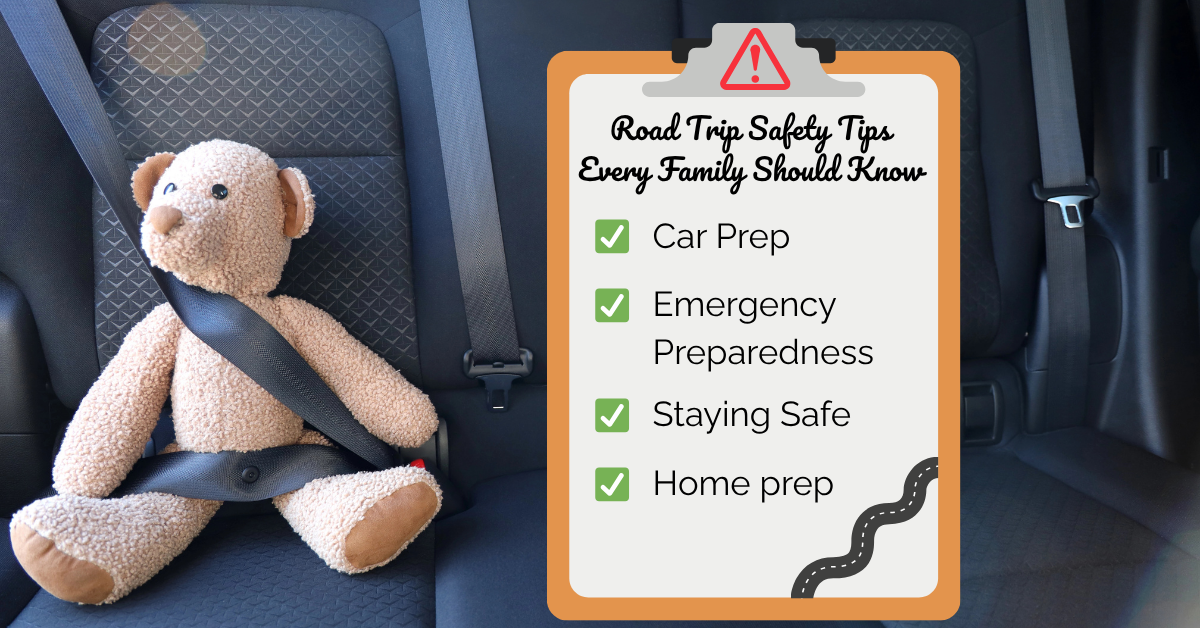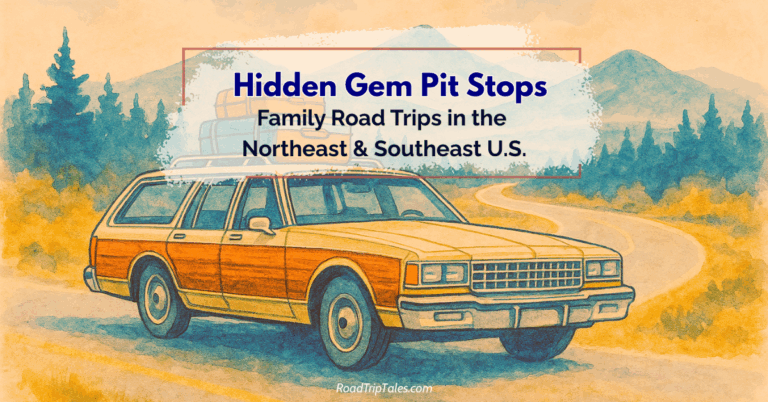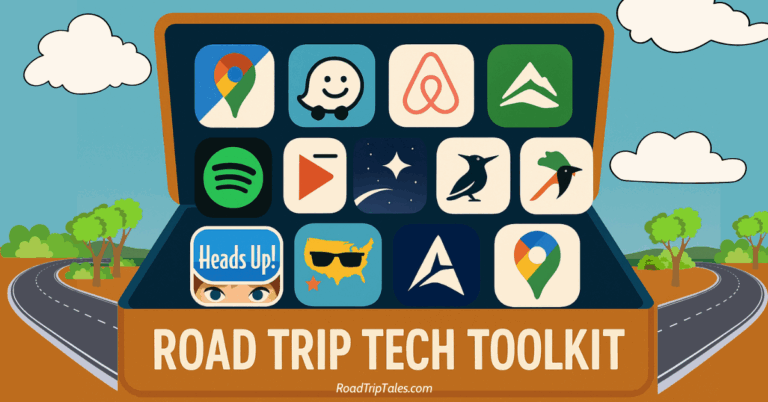The Hard Way, Then the Smart Way
I wish I had these road trip safety tips before I started long drives. When I was younger (and let’s be honest, overconfident), I kicked off a cross-country road trip from New England to California with a buddy—at night. The plan? Take turns napping and driving straight through. That plan lasted exactly 22 hours before my brand-new car overheated on the side of the road. Disappointed and behind schedule, we crashed at a motel, grabbed a slow meal or two, and waited for a mechanic.
Funny thing is—that unplanned stop probably saved our trip. We got the car fixed, caught up on sleep, and hit the road refreshed. It was the moment I realized my limits: 12 hours was too much. Now that I’ve got a family in the backseat and a lot more miles behind me, I rarely go more than 8 hours a day. Even then, we break it up with walks, meals, or something fun off the highway.
That experience taught me that no matter how exciting the destination, safety has to come first. These road trip safety tips are what I rely on now to make sure we all stay safe, rested, and ready to make memories—without a tow truck.
Staying Sharp: Tips to Stay Alert Behind the Wheel
You can’t enjoy the journey if you’re fighting to keep your eyes open. These tips keep me focused and off the rumble strip:
- Swap drivers when you can – even short breaks help reset your brain.
- Avoid late-night starts – a good night’s sleep beats a head start any day.
- Engage your mind – podcasts, audiobooks, and road trip trivia go a long way.
- Use the 2/100 rule – stop every 2 hours or 100 miles to stretch, walk, or refuel.
- Hydrate and snack smart – but avoid sugar bombs and heavy meals that sap energy.
Road-Ready: Prepping Your Car Before You Roll Out
Think of this as your pit crew checklist—no racing stripes required:
- Tires: Check pressure, tread, and don’t forget the spare.
- Fluids: Oil, brake, coolant, washer—you want ‘em full and fresh.
- Brakes & lights: Hit the pedal, flash those signals—make sure everything’s working.
- Emergency kit: Include jumper cables, flashlight, reflective vest, tire inflator, and yes—duct tape.
- Phone-ready tools: Portable charger, offline maps, and your roadside assistance number saved and shared.
- Check the National Highway Traffic Safety Administrations page on Summer Driving Tips or Winter Driving Tips depending on the time of year you are driving.
Bonus move: Schedule a pre-trip inspection at your local mechanic, especially for longer hauls or if you’re towing anything.
Avoiding the “Oops”: Simple Steps That Prevent Big Problems
Most mishaps aren’t dramatic—they’re just…avoidable. A few good habits go a long way:
- Fuel up before you’re empty – don’t rely on the next exit having gas.
- Plan your exits – know when you’ll stop for meals or rest ahead of time.
- Avoid random pull-offs – aim for well-lit, public rest areas or chain gas stations.
- Keep a paper map – your phone’s GPS is only as good as your cell signal.
- Secure your load – loose gear in the trunk can become a projectile in a sudden stop.
- We also check our route using AAA’s TripTik tool for traffic alerts, gas prices, and rest stop suggestions.
Family First-Aid: Be Ready for Medical Surprises
From scraped knees to sudden fevers, here’s how to be the road trip medic (without the drama):
- Pack a real first-aid kit – not just a few Band-Aids. Include pain relievers, tweezers, antiseptic, allergy meds, and anything your crew might need.
- Store medications smart – especially anything temperature-sensitive or time-sensitive.
- Know the route – look up urgent care centers near major overnight stops.
- Keep a family health sheet – allergies, pediatrician contact, insurance info—it’s a lifesaver if you ever need to hand it to a doctor.
Staying Safe at Stops: Crime Prevention on the Road
It’s not something we love to think about—but a few precautions can keep your family safe when staying overnight or pulling over:
- Choose hotels with indoor halls and visible parking lots – better lighting and visibility = fewer problems.
- Park smart – I’ve found that most hotels near the highway keep their lots brightly lit. I always aim to park near the front entrance or at least in a high-traffic area under lights.
- Don’t tempt fate – I never leave anything of real value in the car. At most, I’ll stash items I could afford to lose without derailing the trip.
- Use the hotel deadbolt and security latch – even in nice areas, it’s just good practice.
- Teach your kids a simple buddy rule – no one goes to the bathroom or vending machine alone.
Staying Safe in the City
Big cities like NYC, Atlanta and DC can be incredible road trip stops—museums, food, baseball games, you name it—but they come with their own safety considerations. My go-to approach? Explore by day, stick together, take rideshares after dark. Here are a few more quick tips:
- Plan your parking – Use a well-lit garage or hotel valet if available, and snap a photo of where you parked.
- Avoid wandering too far off the beaten path – Especially at night or when you’re with kids.
- Be transit-wise – Know your route if you’re using a subway or bus, and avoid empty train cars.
- Don’t flash valuables – Keep phones, wallets, and cameras secure when in crowded areas.
- Use trusted rideshare apps after dark – Skip the long walks and confusing directions.
- Teach kids a meeting point – Whether it’s a landmark or a spot near the exit, everyone should know where to regroup if separated.
Protect What You Leave Behind: Home Safety While You Travel
Before you even put the car in drive, make sure your home is protected. A few simple steps can keep things secure while you’re gone:
- Hold your mail – Even for a long weekend. A stuffed mailbox is like a flashing billboard that no one’s home.
- Shut off your water main – Vacation is not the time to find out your upstairs bathroom is leaking.
- Use a pet sitter if you can – Ours stays overnight, keeps the dog happy, and keeps the house looking lived-in. It even costs less than boarding.
- Automate your lights – Set exterior lights on a dusk-to-dawn timer and have an interior light flick on randomly each evening.
- Install security cameras – Even just one or two visible ones can deter break-ins.
- Wait to post trip updates – As tempting as it is to share that epic hike or roadside diner find, hold off until you’re home. Broadcasting your absence can make your house a target.
Bonus Road Trip Safety Tips: What’s in My Car
Essentials for Your Glove Box, First Aid Kit, and Roadside Emergency Gear
🚗 Glove Box Essentials
- Critical Medical Info – for each family member, including allergies and conditions
- Emergency Contact List – names, numbers, and relationship
- Roadside Assistance Number – stored digitally and on paper
- Insurance & Registration – keep digital copies and a backup in your luggage
- Vehicle Owner’s Manual
- Tire Pressure Gauge
- Flashlight – small LED or crank-style
- Disposable Ponchos – for sudden rain or roadside fixes
- Tissues or Napkins
- Wet Wipes and/or Hand Sanitizer
- Pens and Pencils
- Mini First Aid Kit – see below for full kit list
🩹 First Aid Kit
Here is what we have in our kit. You can build your own or follow the Red Cross’s recommended first aid kit.
Basics
- Bandaids – assorted sizes
- Non-Adherent Pads & Gauze
- Antiseptic Wipes
- Antibiotic Ointment
- Liquid Bandage
- Hydrocortisone Cream
Tools & Supplies
- Surgical Tape
- Gloves (non-latex)
- Tweezers
- Small Scissors
- Cotton Swabs
Bonus Items
- Instant Cold Pack
- Moleskin (for blisters)
- Tourniquet
- Butterfly Closures
- Emergency Blanket
- Burn Cream or Aloe
- Afterbite / Sting Relief
- Electrolyte Tablets or Salt Packets
- Eye Drops
- Antihistamine (e.g., Benadryl)
- Antacids
- Acetaminophen (Tylenol)
- Ibuprofen (Advil)
🔧 Roadside Emergency Kit
We pack most of the following in a tote that stays in the trunk for our long trips. Ready.gov has a full list of recommended emergency items for vehicles.
- Jumper Cables or Car Battery Charger
- Jack
- Headlamp or Extra Flashlight (with batteries)
- Reflective Triangles, Flares, or LED Light Stick
- Reflective Safety Vest
- Blanket or Space Blanket
- Bottled Water – 1 per passenger in case of breakdown
- Energy Bars or Shelf-Stable Snacks
- Work Gloves
- Duct Tape
- Zip Ties
- Multi-tool (with knife, pliers, etc.)
- Safety Hammer / Glass Breaker – store within driver’s reach
Final Thoughts: Make Safety Part of the Adventure
You don’t need to bubble-wrap your kids or prep like you’re heading into the wilderness—but having a solid safety plan gives you the freedom to focus on the fun stuff. With these road trip safety tips, you’ll be ready for the unexpected and fully present for the moments that matter—whether it’s a detour through a quirky small town or a perfect sunset at your final stop.








